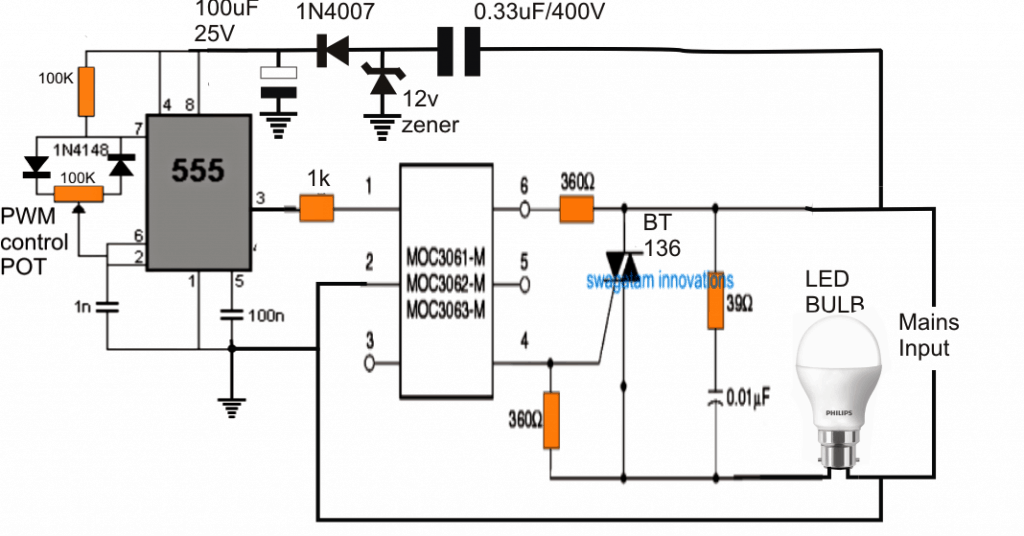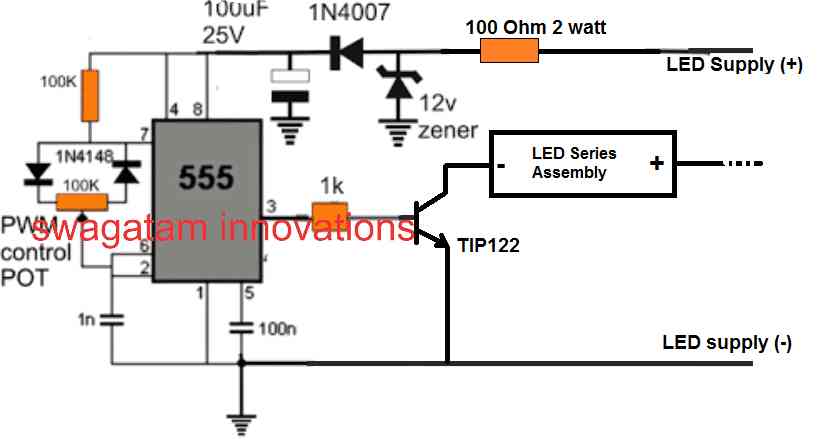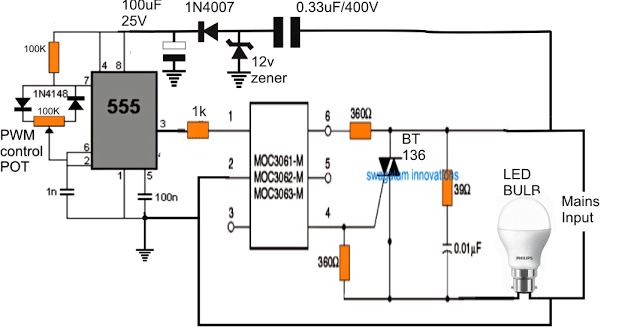In this article I have explained how to make an LED dimmer circuit for enabling a dimming facility to any mains operated LEDs bulb.
How LED Bulbs Work
We know that our ceiling fans and incandescent bulbs can be easily controlled using triac dimmer switches, and we are quite used to with dimmer switches in our homes installed for controlling such devices.
However with the advent of LED bulbs and tubes, incandescent bulbs are slowly making an exit, and our home bulb holders are getting replaced with LED bulbs.
LED bulbs come with a built in SMPS driver within their holder cabinet, and an SMPS circuit makes it difficult to operate or control through a triac dimmer switches, until and unless its suitably modified for the application.
Because, the SMPS driver inside LED bulbs and tubes strictly employ inductor or capacitive based circuits which are never recommended to be used through triac dimmers, since triac dimmers utilize phase chopping technology for the dimming purpose which unfortunately does not suit inductive/capacitive load control.
If used then the LED bulbs do not dim correctly rather show erratic dimming or brightening behavior, due to an incompatible reaction.
The best method and probably the technically correct approach is the PWM technology which can be effectively used for controlling or dimming LED bulbs or tubes. The figure shows the design may be implemented.

You may also like: Simple DC Lamp Dimmer Circuit
How it Works
The idea is actually very simple, thanks to the MOC series opto couplers which make triac control through PWM extremely easy and compatible.
The right side of the figure comprises a standard MOC3063 IC based triac controller circuit which is operated through an IC 555 based PWM circuit shown at the left side of the figure.
The IC 555 is configured as a standard adjustable PWM generator which feeds the desired PWM to the input pin#1/2 of the MOC IC.
The adjustable PWMs are appropriately processed by the IC through its built in zero crossing detector circuit and photo triac which is ultimately used for controlling an external triac BT136 via its output pin#4/6.
The connected LED bulb now responds to the PWM content applied by the 555 circuit and proportionately adjusts its brightness as per the user preference.
The PWM control is executed through the associated 100K pot, which must be suitably insulated, as the whole circuit is not isolated from mains current.
The circuit is not isolated from mains despite of the opto coupler due to fact that the IC 555 requires a DC supply for operating which is supplied from anon-isolated transformerless power supply, this is done in order to keep the design compact and avoid the use of costly SMPS module which could have been otherwise an overkill.
If you have any concerned question regarding the above explained dimmer circuit for LED bulb, you can express them through your comments.
UPDATE:
A deeper inspection of the above concept shows that the concept might not work due to the presence of the internal filter capacitor in every LED bulb circuit, right after the bridge rectifier.
This filter capacitor will hold the charge and keep the LED bulb ON even during the OFF times of the PWMs, preventing the dimming effect.
This means that dimming an LED bulb through an external means can be impossible.
However, the dimming effect can be perhaps implemented by connecting the series LED section of the LED bulb with the IC 555 circuit, as indicated in the following diagram:

We know that an LED bulb circuit is nothing but a small AC to DC SMPS circuit, which employs a small ferrite transformer for stepping down the mains voltage to a lower LED DC voltage. The secondary side of the transformer produces the stepped down voltage which is rectified by a single diode and a large filter capacitor.
The rectified DC is then transferred to a series LED assembly for lighting it up.
We have to modify this LED section and connect it with the IC 555 PWM stage as shown above.
This can be implemented wiht the following steps:
- Open the LED bulb container.
- Cut the wire of the LED assembly which goes to the negative line of the DC supply.
- Connect this negative LED wire to the transistor collector of the 555 pwm circuit.
- Finally connect the 555 pwm circuit's positive/negative wires with the LED DC supply, coming from the ferrite transformer secondary.
- This also means that the 555 IC circuit does not need an external DC, and it can be derived from DC supply from the smps, meant for driving the LEDs.
- Finally, connect the LED smps input to AC mains and check the dimming effect by varying the IC 555 pwm pot.
- Remember the smps circuit primary side is not isolated from mains and therefore extremely dangerous to touch in switched ON condition.
